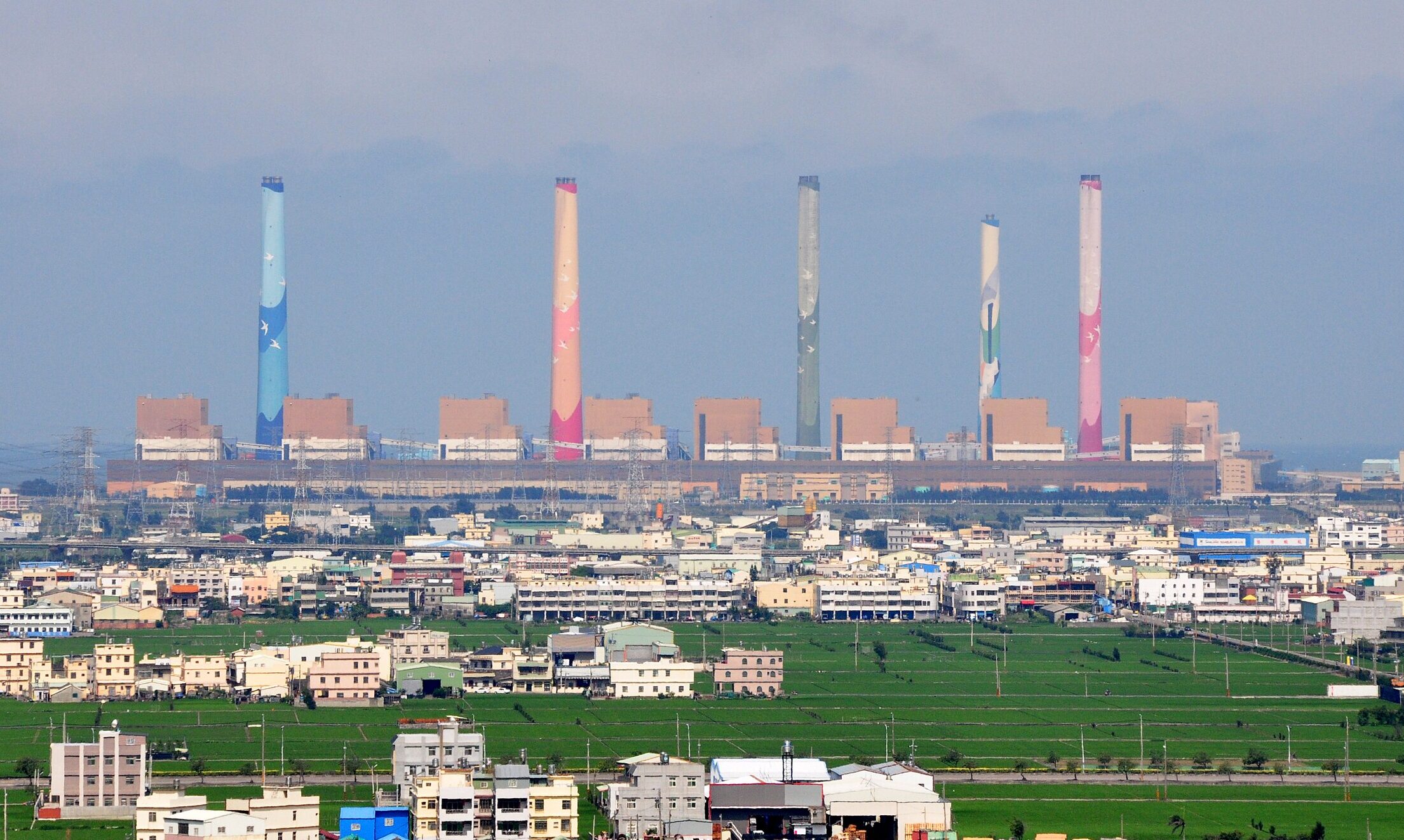
The article is published as part of a joint issue “Green Synergies: Sustainability, Security and Taiwan-Europe Collaboration” between CHOICE and the University of Nottingham’s Taiwan Insight.
Taiwan’s reliance on imported fossil fuels presents a critical vulnerability in the island’s energy security, making the transition to renewable energy a major step toward greater national resilience. Developing domestic renewable energy sources and strategically managing supply chain dependencies are crucial for Taiwan to strengthen both its energy and national security in an evolving geopolitical landscape.
In Taiwan, concerns about energy security focus primarily on the country’s heavy dependence on thermal power generated from imported fossil fuels – often described as the “Achilles’ heel” in its security framework. According to statistics from the Energy Administration, in 2024, 39.3 percent of electricity generation came from coal and 42.4 percent from liquefied natural gas (LNG), all of which is imported. Renewables accounted for only 11.6 percent of the share.
The government targets to have an energy mix of 50 percent natural gas, 30 percent coal, and 20 percent renewables by 2025, making LNG the largest component of Taiwan’s energy portfolio. To meet this goal, the government plans to increase LNG reserves from the current 11-day supply to 14 days by 2027. However, Taiwan’s heavy reliance on LNG has emerged as a politically contentious issue, particularly amid concerns that such dependence heightens Taiwan’s vulnerability to price volatility associated with geopolitical risks – most notably, the potential risk of a maritime blockade by China.
A closer examination of Taiwan’s energy security index (Table 1) over the past decade reveals only a slight decrease in its dependence on imported energy – from 97.67 percent to 95.63 percent. This marginal reduction can be attributed primarily to the expansion of renewable energy and the gradual contraction of the petrochemical sector. Nevertheless, the country’s overall reliance on imported energy remains remarkably high. On average, imported energy accounts for 14.4 percent of the total national expenditure, with a peak of 18 percent in 2022, when global fuel prices surged due to the outbreak of the war in Ukraine.
Because of Taiwan’s high reliance on imported energy and its subsequent vulnerability to market volatility, energy security is a critical concern. Conventional strategies – such as diversifying import sources and relying on nuclear power as the ultimate solution – are insufficient in providing the resilience necessary to withstand rapid and unpredictable geopolitical disruptions. This article argues that renewable energy development offers a vital pathway to greater resilience of Taiwan, aligning with the growing recognition of energy transition as a critical component of national security, beyond its environmental imperative. The article seeks to debunk common misconceptions that hinder Taiwan’s energy transition while advocating for forward-looking, strategic planning to navigate geopolitical uncertainty.
| Year | Dependence on Imported Energy (%) | Value of Energy Imports / Total Imports (%) |
| 2015 | 97.67 | 15.36 |
| 2016 | 97.58 | 12.73 |
| 2017 | 97.70 | 14.86 |
| 2018 | 97.51 | 17.19 |
| 2019 | 97.28 | 15.12 |
| 2020 | 97.28 | 10.19 |
| 2021 | 97.19 | 12.53 |
| 2022 | 96.65 | 18.12 |
| 2023 | 96.20 | 15.83 |
| 2024 | 95.63 | 12.81 |
Table 1: Taiwan’s key energy security indicators. Source: Energy Administration, MOEA
Energy Transition as the New National Security
The concept of “energy transition as national security” has gained prominence due to two key developments: the urgent need to address climate change and extreme weather events, and the escalating concerns about national security. A turning point was Russia’s invasion of Ukraine in 2022. The surge in fuel prices accelerated the deployment of renewable energy in Europe. As a result, European countries now see clean energy development as a means to reduce dependence on authoritarian petrostates like Russia. Clean energy thus becomes the key to both current energy and future climate security. Some even argue that security concerns, rather than climate change, will become the primary driver of the energy transition, with sovereign states diversifying their energy mix across multiple sources to insulate themselves from geopolitical, macroeconomic, and financial risks.
Another factor is President Trump’s new trade order. With 74 percent of the world’s population living in fossil fuel-importing countries – a dependency historically shaped by the US-led geopolitics and oil-dominated markets – Trump has turned fossil fuels into trade bargaining chips to balance the US trade deficit. For example, the East Asian countries, including Japan, Korea, and Taiwan, were pressed to invest in Alaska’s LNG project, while the EU was forced to modify its methane leakage standards for LNG imports. As confidence in securing oil and gas erodes, policymakers are increasingly turning to domestic energy sources, namely renewables and electrification. Countries believe that the transition to clean energy could create a world that is less susceptible to energy price shocks and geopolitical trade risks.
The dependence on imported fossil fuels remains a profound concern for national security. A former US Assistant Navy Secretary even claimed that domestic clean energy deployment may be the greatest step to ensuring national security. Similarly, several EU think tanks had urged the European Commission to include green energy in its increased security spending under the EU’s next multi-annual financial framework. Taiwan should, therefore, follow and design its energy security strategy based on this new concept of national security.
Taiwan’s Energy Security: Debunking Three Persistent Myths
Three myths continue to cloud the debate about Taiwan’s energy security. First, Taiwan’s heavy reliance on energy imports renders it incapable to withstand a Chinese blockade. Second, dependence on Chinese clean technology undermines Taiwan’s energy security. And third, a fundamental trade-off exists between food and energy security, especially in the use of land for renewable energy projects. These myths, however, do not hold up under closer examination.
In the wake of China’s latest military drills, during which LNG terminals were explicitly identified as potential targets, Taiwan’s LNG reserves have become a political flashpoint. Critics argue that Taiwan’s energy transition strategy, which includes a move away from nuclear and toward renewables, weakens energy security. Much attention has been paid to Taiwan’s LNG reserves, which are typically sufficient for 11 to 14 days under normal consumption. But this metric is misleading. In a blockade scenario, Taiwan’s total energy demand would likely plummet –potentially by 50 percent – as industrial exports halt. Under these conditions, Taiwan’s existing coal-fired power plants, combined with a growing renewable energy capacity, could sustain the island’s electricity needs for over a year.
Crucially, the success of this transition depends on the rapid deployment of renewable resources. Some have questioned whether this strategy is viable, given China’s dominance in the global clean energy supply chains. However, Taiwan retains significant domestic solar panel manufacturing capacity and has banned imports of Chinese-made solar modules since 2022. As for energy storage – a vital component of flexible power grids – Taiwan is on track to produce 13 GWh of batteries annually by 2027, which is enough to support its renewable energy ambitions.
Another common argument from skeptics is that Taiwan’s increasing dependence on food imports – currently around 70 percent – poses a new vulnerability, especially if utility-scale solar projects encroach on agricultural land. But this concern is overstated. Taiwan’s self-sufficiency rate for rice – its staple crop – remains at impressive 98 percent, even with 6 percent of farmland currently lying fallow. In fact, allocating less than 10 percent of Taiwan’s agricultural land to solar projects could allow solar power to cover up to one third of the island’s electricity needs. Food security, in other words, is not threatened. Using it as a rhetorical weapon against renewable energy deployment is misleading and disingenuous.
Energy security is a serious issue that deserves a serious conversation. Clinging to outdated myths only serves to undermine thoughtful policymaking. Taiwan’s path to a resilient energy future requires realistic assessments, not fear-driven narratives detached from the facts.
A Real Tabletop Exercise on Energy
A tabletop exercise (TTX) tackling Taiwan’s national security challenges is held annually by Taiwanese think tanks. These simulation exercises see key stakeholders discussing and analyzing responses to different threat scenarios, including Taiwan Strait crisis or economic disruptions. Besides the threat from China, a TTX specifically focused on energy transition is needed to debunk the aforementioned myths and build robust policy frameworks.
US-based think tank, the Center for Climate and Security, has conducted similar tabletop exercises in Japan and South Korea. These simulations have emphasized the idea that “clean energy is national security” by demonstrating how disruptions from extreme weather events and geopolitical shifts threaten energy security of countries heavily dependent on imported fossil fuels. Scenarios included acute crises – such as halving of fossil fuel imports due to militarization of the Taiwan Strait – as well as chronic or non-acute threats like the compounding effects of climate change on critical infrastructures essential to national defense and public security.
Importantly, these exercises recognized that a clean energy transition is not without its own risks. Participants were made aware of new vulnerabilities emerging from the shift to clean energy, particularly the global reliance on China for critical minerals used in clean technology. While this dependence may be less immediately destabilizing and more easily mitigated than fossil fuel dependence, it presents strategic risks to long-term national security. NATO, the EU, the US, and Japan have all echoed this warning.
The Way Forward
The challenge of supply chain dependency can be addressed through targeted innovation and strategic planning. Technological advances, such as the development of cobalt-free or nickel-free batteries, offer viable alternatives to current supply chain constraints. Furthermore, building democratic and diversified supply chains – anchored in cooperation with like-minded partners – creates a pragmatic path forward. Sourcing critical materials from a wider range of geopolitical allies can significantly reduce systemic risks.
Conducting a dedicated TTX on energy transition would provide Taiwan with a strategic opportunity to assess both its strengths and vulnerabilities under various clean energy adoption scenarios. Such an exercise would not only help identify critical infrastructure and policy gaps but also support a more integrated approach to enhancing both national and energy security in the context of global decarbonization.
Written by
Yun-Ling Ko
yunlingkoYun-Ling Ko is a researcher at Taiwan Climate Action Network (TCAN) with seven years of experience working in the renewable energy industry. She holds an MA and BA from National Taiwan University.
Chia-Wei Chao
MacondoChaoDr Chia-Wei Chao is the Research Director at Taiwan Climate Action Network (TCAN) and an Adjunct Assistant Professor at National Taiwan University’s Program on Climate Change and Sustainable Development.


